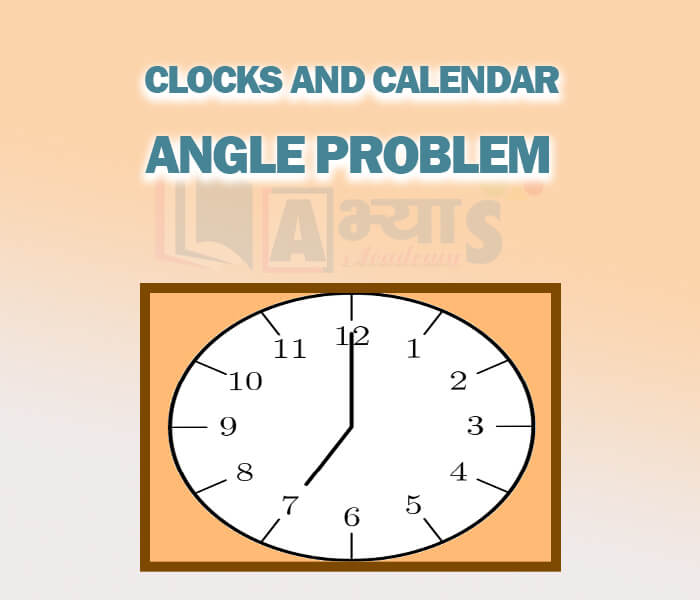Clocks and Calendar - Angle Problem








Clocks and Calendar - Angle Problem
Clock: A Clock is a very common device used to know the time at a particular instance. It is generally circular in shape with three hands indicating hours, minutes and second viz. an hour hand, minute and second hand. The study of the clock is known as horology

Structure of a Clock: A basic structure of a clock consists of three hands indicating Hours, minutes and seconds. In the figure above the red hand indicates the second, smaller black hand indicates hours and the larger black hand indicates minutes.The total angle around a point is 360 degree so each hand has to traverse an angle of 360 degree to complete one rotation. These 360 degrees are divided into 12 equal divisions. The angle between the consecutive divisions is obtained by dividing the total angle of clock 360 degree by the number of divisions i.e. 12. Each division indicates the hours at that time.
The angle between any two consecutive divisions
The angular space between any two consecutive divisions for the hours is further divided into five more divisions. These divisions indicate the minutes.The angular distance traversed by the minutes hand in one minute can be calculated by, dividing the 30 degree by five and is known as the angular value of a minute.
Angular value of a minute
Angle Problems in Clocks: This concept revolves around the calculation of the angular distance traversed by the different hand of the clock. The different hands of the clock move with different speed.The hour hand takes 12 hours to traverse an angle of 360 degree.
Speed of hour hand = in 12 hours
= in 1 hour ( 60 min )
=
Speed of minute hand = in 1 hour ( 60 min )
= per minute
As they are moving in the same direction
So, the relative speed of minute hand over hour hand will be difference of their speed
This means that the minute hand approaches and races away from the hour hand at a speed of per minute.
Ex.1 What will be the angle between the hour hand and the minute hand at 3 : 40 pm?
Sol. At 3 pm, the angel is .
In 40 minutes, the minute hand would cover = over the hour hand.
So, the new angle = .
Alternate Solution
Ignoring the movement of hour hand and considering hour hand to be fixed at 3, the angle between the hour hand and the minute hand at 3:40 pm will be
This is considering the fact that every hour mark is at an angle of from the previous one .
Now, let us account for the movement of hour hand from 3 pm to 3:40 pm.
The time elapsed = 40 minutes.
So, the angle covered by hour hand minutes
Now, it is clear that the movement of hour hand decreases the angle, which otherwise was calculated to be
So, the correct angle
What will be the angle between the hour hand and the minute hand at 12 : 50 pm? | |||
| Right Option : B | |||
| View Explanation | |||
What will be the angle between the hour hand and the minute hand at 9: 00 pm ? | |||
| Right Option : D | |||
| View Explanation | |||
What will be the angle between the hour hand and the minute hand at 1 : 50 am? | |||
| Right Option : C | |||
| View Explanation | |||
Students / Parents Reviews [20]
When I have not joined Abhyas Academy, my skills of solving maths problems were not clear. But, after joining it, my skills have been developed and my concepts of science and SST are very well. I also came to know about other subjects such as vedic maths and reasoning.

Sharandeep Singh
7thMy experience was very good with Abhyas academy. I am studying here from 6th class and I am satisfied by its results in my life. I improved a lot here ahead of school syllabus.

Ayan Ghosh
8thIt has a great methodology. Students here can get analysis to their test quickly.We can learn easily through PPTs and the testing methods are good. We know that where we have to practice

Barkha Arora
10thAbhyas Methodology is very good. It is based on according to student and each child manages accordingly to its properly. Methodology has improved the abilities of students to shine them in future.

Manish Kumar
10thAbhyas is an institute of high repute. Yogansh has taken admission last year. It creates abilities in child to prepare for competitive exams. Students are motivated by living prizes on basis of performance in Abhyas exams. He is satisfied with institute.

Yogansh Nyasi
7thBeing a parent, I saw my daughter improvement in her studies by seeing a good result in all day to day compititive exam TMO, NSO, IEO etc and as well as studies. I have got a fruitful result from my daughter.

Prisha Gupta
8thAbhyas is good institution and a innovative institute also. It is a good platform of beginners.Due to Abhyas,he has got knoweledge about reasoning and confidence.My son has improved his vocabulary because of Abhyas.Teacher have very friendly atmosphere also.

Manish Kumar
10thAbhyas institute is one of the best coaching institute in the vicinity of Ambala cantt.The institute provides good and quality education to the students.The teachers are well experienced and are very helpful in solving the problems. The major advantages of the institute is extra classes for weak...

Shreya Shrivastava
8thIn terms of methodology I want to say that institute provides expert guidence and results oriented monitering supplements by requsite study material along with regular tests which help the students to improve their education skills.The techniques of providing education helps the students to asses...

Aman Kumar Shrivastava
10thMy experience with Abhyas Academy has been very good. When I was not in Abhyas whenever teacher ask questions I could not speak it confidently but when I came in Abhyas, my speaking skills developed and now I am the first one to give the answer of teachers question.

Upmanyu Sharma
7thMy experience with Abhyas academy is very good. I did not think that my every subject coming here will be so strong. The main thing is that the online tests had made me learn here more things.

Hiya Gupta
8thMy experience with Abhyas academy is very nice or it can be said wonderful. I have been studying here from seven class. I have been completing my journey of three years. I am tinking that I should join Abhyas Academy in tenth class as I am seeing much improvement in Maths and English

Hridey Preet
9thOne of the best institutes to develope a child interest in studies.Provides SST and English knowledge also unlike other institutes. Teachers are co operative and friendly online tests andPPT develope practical knowledge also.

Aman Kumar Shrivastava
10thAbhyas academy is great place to learn. I have learnt a lot here they have finished my fear of not answering.It has created a habit of self studying in me.The teachers here are very supportive and helpful. Earlier my maths and science was good but now it has been much better than before.

Barkha Arora
10thThird consective year,my ward is in Abhyas with nice experience of admin and transport support.Educational standard of the institute recumbent at satisfactory level. One thing would live to bring in notice that last year study books was distributed after half of the session was over,though study ...

Ayan Ghosh
8thIt was good as the experience because as we had come here we had been improved in a such envirnment created here.Extra is taught which is beneficial for future.

Eshan Arora
8thAbout Abhyas metholodology the teachers are very nice and hardworking toward students.The Centre Head Mrs Anu Sethi is also a brilliant teacher.Abhyas has taught me how to overcome problems and has always taken my doubts and suppoeted me.

Shreya Shrivastava
8thUsually we see institutes offering objective based learning which usually causes a lag behind in subjective examinations which is the pattern followed by schools. I think it is really a work of planning to make us students grab the advantages of modes of examination, Objective Subjective and Onli...

Anika Saxena
8thMy experience with Abhyas is very good. I have learnt many things here like vedic maths and reasoning also. Teachers here first take our doubts and then there are assignments to verify our weak points.

Shivam Rana
7thWe started with lot of hope that Abhyas will help in better understnding of complex topics of highers classes. we are not disappointed with the progress our child has made after attending Abhyas. Though need to mention that we expected a lot more. On a scale of 1-10, we would give may be 7.
